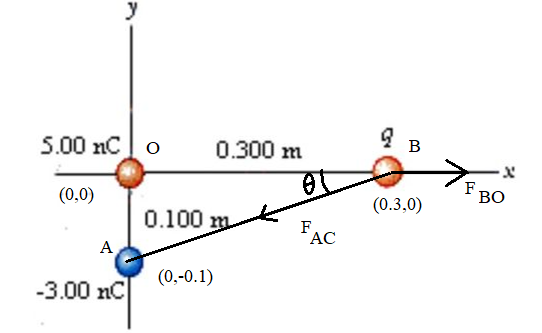Two source charges (5.0 nC and -3.0 nC) are located on the y-axis respectively at y = 0 and y = -0.10 m, as shown below. A test charge q is located on the x-axis at x = 0.30 m. The test charge is repelled by the 5.0-nC source charge and attracted to the -3.0-nC source charge. (a) (b) (c) 5.00 nC -3.00 nC 0.300 m 0.100 m 2 x First, indicate whether the test charge is positive or negative. Then, letting |q| = 9.0 nC, find the magnitude and direction of the net electric force on the test charge. (Specify the direction as an angle measured counterclockwise from the +x axis.) Now suppose the test charge q is removed, and only the two source charges remain. Consider three regions along the y-axis: (i) above 5.0 nC, (ii) between 5.0 nC and -3.0 nC, and (iii) below -3.0 nC. In which region(s), other than infinity, is it possible for the net electric potential to be zero? Justify your answer(s) qualitatively, but do not perform any calculations. The net electric field produced by the two source charges is zero at a certain point on the y-axis below the -3.0-nC charge. Determine the (finite) y coordinate of this point. (Note: The solution does not require use of the quadratic formula. If your equation appears quadratic, take the square root of both sides to obtain a linear equation that can be solved more easily.)
Two source charges (5.0 nC and -3.0 nC) are located on the y-axis respectively at y = 0 and y = -0.10 m, as shown below. A test charge q is located on the x-axis at x = 0.30 m. The test charge is repelled by the 5.0-nC source charge and attracted to the -3.0-nC source charge. (a) (b) (c) 5.00 nC -3.00 nC 0.300 m 0.100 m 2 x First, indicate whether the test charge is positive or negative. Then, letting |q| = 9.0 nC, find the magnitude and direction of the net electric force on the test charge. (Specify the direction as an angle measured counterclockwise from the +x axis.) Now suppose the test charge q is removed, and only the two source charges remain. Consider three regions along the y-axis: (i) above 5.0 nC, (ii) between 5.0 nC and -3.0 nC, and (iii) below -3.0 nC. In which region(s), other than infinity, is it possible for the net electric potential to be zero? Justify your answer(s) qualitatively, but do not perform any calculations. The net electric field produced by the two source charges is zero at a certain point on the y-axis below the -3.0-nC charge. Determine the (finite) y coordinate of this point. (Note: The solution does not require use of the quadratic formula. If your equation appears quadratic, take the square root of both sides to obtain a linear equation that can be solved more easily.)
Related questions
Question

Transcribed Image Text:Problem 1
=
Two source charges (5.0 nC and -3.0 nC) are located on the y-axis respectively at y
-0.10 m, as shown below. A test charge q is located on the x-axis at x = 0.30 m.
charge is repelled by the 5.0-nC source charge and attracted to the -3.0-nC source charge.
(a)
(b)
(c)
5.00 nC
y
-3.00 nC
0.300 m
0.100 m
X
0 and y
-
The test
First, indicate whether the test charge is positive or negative. Then, letting || = 9.0 nC,
find the magnitude and direction of the net electric force on the test charge. (Specify the
direction as an angle measured counterclockwise from the +x axis.)
Now suppose the test charge q is removed, and only the two source charges remain.
Consider three regions along the y-axis: (i) above 5.0 nC, (ii) between 5.0 nC and -3.0
nC, and (iii) below -3.0 nC. In which region(s), other than infinity, is it possible for the
net electric potential to be zero? Justify your answer(s) qualitatively, but do not perform
any calculations.
The net electric field produced by the two source charges is zero at a certain point on the
y-axis below the -3.0-nC charge. Determine the (finite) y coordinate of this point. (Note:
The solution does not require use of the quadratic formula. If your equation appears
quadratic, take the square root of both sides to obtain a linear equation that can be solved
more easily.)
Expert Solution
Step 1
Given that:

Step by step
Solved in 4 steps with 2 images
